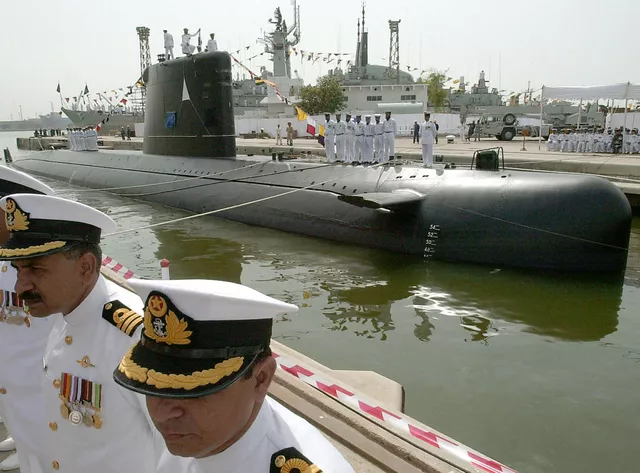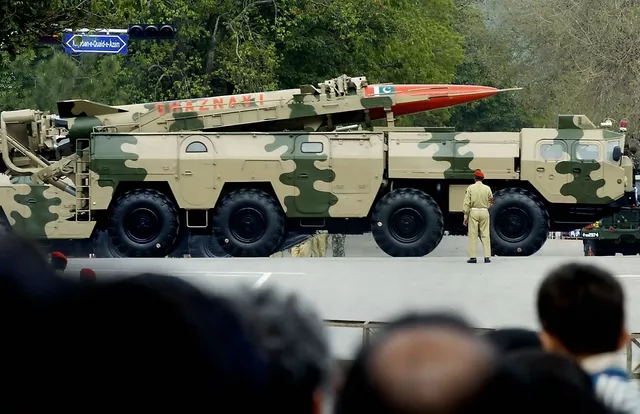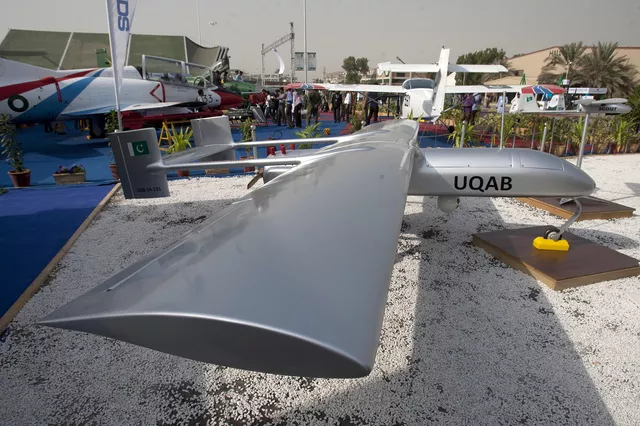The Indian army is larger, but Pakistan also has significant striking power.
Pakistan is pursuing a particularly brutal kind of pragmatic policy. To ensure such a policy, Islamabad has created a wide range of destructive tools, ranging from terrorist groups to nuclear weapons. Here are the five most dangerous types of Pakistani weapons that could pose a threat to India in an emergency situation.
Kyle Mizokami
Since 1947, Pakistan has been inferior to the larger and more powerful India. Its army is much weaker than India's and will lose out in the event of a non-nuclear war, although Pakistan spends 50% more on defense as a share of GDP. Like North Korea, Pakistan is a weakening State that secures its territorial integrity in an inexpensive way by investing in nuclear weapons. An attack on Pakistan is extremely dangerous because it is a sure way to provoke a nuclear war. In this regard, Pakistan's nuclear program should be considered a great success.
Pakistan is pursuing a particularly brutal kind of pragmatic policy, constantly pitting one side against the other in order to distract everyone's attention from its own weaknesses and shortcomings. To ensure such a policy, Islamabad has created a wide range of destructive tools, ranging from terrorist groups to nuclear weapons. And all these means are directed against India. India has to take into account a variety of extraordinary circumstances and actions on the part of Pakistan, from terrorism to nuclear war. Here are the five most dangerous Pakistani weapons that could pose a threat to India in an emergency situation.
JF-17 Thunder Fighter Bomber
The inexpensive single-engine multipurpose fighter JF-17 Thunder was jointly developed by Chengdu Aircraft Industry Corporation (it also developed the J-20 fighter) and the Pakistan Aeronautical Complex. In total, 200 JF-17s can be built for the Pakistani Air Force, which are significantly superior in their characteristics to the Mirage-3, Mirage-5 and F-7 aircraft available in Pakistan. The JF-17 should form the basis of the fighter aircraft of the Pakistani Air Force.
Pakistan, which is a traditional buyer of American weapons, purchased several dozen F-16 fighter jets in the 1980s and 1990s. The first 40 aircraft were delivered, but the second batch of 28 aircraft did not reach Pakistan because the Americans disapproved of its nuclear program. For this reason, Pakistan has decided to diversify the range of suppliers. At the same time, the military aircraft industry began to develop rapidly in China, and as a result, the JF-17 Thunder was born due to Pakistan's needs for fighter jets.
Externally, the JF-17 is similar to the fighters available in the Pakistani Air Force, especially the French Mirage-5 and the American F-16. It's hardly a coincidence. The similarity hints at the fact that China has carefully studied both fighters. The JF-17 made its first flight in Chengdu, China, in August 2003, and production of this machine began in 2007.
The JF-17 Thunder has many details inherent in modern fighters. These are an electro-remote flight control system, a pulse Doppler radar station for detecting targets and conducting air combat, an in-flight refueling system, a laser designator for combating ground targets, a modern electronic warfare system and an ergonomic cockpit with instrument readings on the windshield and multi-color digital displays. The aircraft has benefited greatly from the breakneck development of the Chinese aerospace industry, as it is planned to install new engines, a new optoelectronic helmet-mounted targeting system and more advanced avionics in the near future.
The JF-17 has five weapon suspension units, which can accommodate 3.6 tons of fuel, weapons or ammunition. China supplies weapons for aerial combat. These are short-range missiles with the PL-5 and PL-9 infrared homing system, which are mounted on nodes in the wing tips. To conduct aerial combat beyond the line of sight, the JF-17 will be equipped with Chinese PL-12 active radar homing missiles. Less is known about air-to-ground weapons, but most likely they will be various unguided bombs, laser-guided bombs, containers with unguided missile weapons, precision guided missiles and anti-ship missiles.
 |
| The Pakistani submarine Saad. |
| Source: AP Photo / Anwar Abbas |
Khalid series submarine
The Indian Navy is superior to the Pakistani Navy in almost all respects. There are more personnel, more ships and planes. And India is significantly ahead of Pakistan in terms of technology. The most effective equipment in the Pakistan Navy is three diesel-electric attack submarines of the Khalid type. The three of these boats can ensure the exclusion of access/blocking of the zone, being used against the Indian Navy trying to establish a blockade of Karachi and other ports.
The Khalid series boats are an upgraded version of the French diesel-electric Agosta submarines. "Khalid", "Saad" and "Hamza" are small in size, and their underwater displacement is 2,050 tons. The speed on the surface is 12 knots, and underwater is slightly more than 20 knots. All three submarines have an air-independent propulsion system, which allows them to stay underwater longer, where they are very difficult to detect.
The Khalid-class boats are armed with torpedo tubes with a standard diameter of 533 mm. They can be used to launch French-made ECAN F17 Mod 2 torpedoes with wire control. They have both active and passive guidance. The torpedo can deliver a 250 kg warhead at a range of up to 20 km. Targets at a greater distance are hit by the famous Exocet anti-ship missile. The underwater version of this SM39 missile has a range of up to 50 km and a warhead weight of 165 kg.
 |
| The Pakistani ballistic missile "Ghaznavi". |
| Source: AFP 2019 / Jewel Samad |
Pakistan's nuclear weapons
Pakistan decided to build a nuclear arsenal after the 1971 war with India. He confirmed his intention in 1974, when India tested an atomic bomb. The nuclear program in Pakistan was led by the infamous Dr. Khan, who is considered the "father of the Pakistani bomb." In 1998, Islamabad shocked the whole world by simultaneously detonating several nuclear devices with a capacity of one to 36 kilotons.
The number of nuclear weapons Pakistan has is unknown, but it is estimated to be between 90 and 110 units. This figure is derived from the amount of fissile material produced in Pakistan. Pakistani nuclear weapons can be delivered to the target in two ways: These are aerial bombs and ballistic missiles. It is possible that the first models of Pakistani F-16 fighter-bombers were intended in the late 1990s to deliver free-fall atomic bombs to the target. After taking off from Pakistan's Sargodha air base, the F-16A with nuclear weapons could reach central India. Well, that's if he had overcome the Indian air defense system.
Pakistan has two short-range tactical ballistic missiles.: "Ghaznavi" and "Shahin". He is currently developing two more short-range missiles: the Abdali and the Nasr. For long-range strikes, Pakistan has an unknown number of Gauri-2 missiles, which were adopted in the 1990s. It is a liquid-fueled rocket with a single stage and a launch range of approximately 2,000 km. It is mobile, transported by road. Theoretically, this missile can hit 80% of Indian territory. There is also a newer medium-range ballistic missile, the Shahin-2, which runs on solid fuel and has a range of 2,000 km.
Despite the fact that Pakistan has a rich arsenal of nuclear weapons and their means of delivery, it cannot be said that they are reliable and well protected. The issue of the physical safety of Pakistani nuclear weapons in the face of a possible military coup or terrorist attack is a matter of concern in the West and especially in the United States. And the fact that Pakistan has a wide variety of missile projects shows that the first designs were not very successful.
Terrorist groups
Perhaps the most dangerous weapons in Pakistan's arsenal are terrorist groups.
The danger for India is that these groups, especially if they are preparing and carrying out attacks against the civilian population, may force the Indian government to launch a retaliatory military strike against Pakistan.
In addition, they can force the Indian authorities to take such measures that will lead to a major war between the two countries. India can put into effect its cold-launch non-nuclear war doctrine, according to which the Indian army must defeat the Pakistani army and then quickly enter Pakistan. In this case, Pakistan may use nuclear weapons, India will respond in kind, and it will be a nuclear war between the two countries.
 |
| The Pakistani UQAB drone. |
| Source: AP Photo / Shakil Adil |
Unmanned aerial vehicles (UAVs)
Since Pakistan has been staging provocations against its neighbor India for a long time, the introduction of drones into service with the Pakistani army is not very good news. Since 2008, Islamabad has been using two small UAVs for tactical reconnaissance, called the Shahpar and Ukab. Although these drones have a traditional purpose, the presence of such devices in the Pakistani army suggests that they may be used for more malicious purposes than conducting reconnaissance and ensuring the security of troops.
Global Industrial Defense Solution, a Pakistani defense contractor, gives the following description to the smaller of the two Ucab drones: "This is a combat UAV that can be used to assess damage on the battlefield, conduct aerial reconnaissance, adjust artillery fire, conduct search and rescue operations, track the route, providing assistance to flood victims and so on." The flight range of the Ukaba is 150 kilometers, and the flight duration is six hours. It has a twin-keeled tail and a single turboprop engine. Ukab is capable of speeds up to 150 km/h. It is equipped with a GPS navigation system, has a full-color camera that works in real time, as well as a thermal night vision device.
The Shahpar drone, which is also manufactured at Global Industrial Defense Solution, is slightly larger and faster. It exceeds the Ukab by 15% in size, and its maximum speed is 150 km/h. The Pakistanis are making some efforts to reduce the radar visibility of this drone, but this is difficult to achieve due to the large screw that is attached to the back. The flight time has been increased to seven hours, and the data link allows for real-time video transmission over a range of up to 250 km. Shakhpar is capable of independently taking off, flying and landing using GPS.
India should be wary of Shahpar and Ukab drones, because they ideally complement small armed groups, whether they are Pakistani rangers or militants from Lashkar-e-Taiba, sent to carry out sabotage against some border post or in a large city. Drones can be used for reconnaissance purposes, flanking and guarding, as well as for obtaining intelligence in real time. The Shakhpar, which has a payload of up to 50 kg, can even be used for clandestine cargo delivery.


